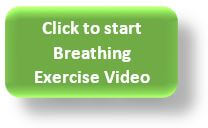
Left: Jill Crockett, Molcintah Yoga Studio, Right: Julie Rowin, MD
RECAP: Conquer MG Webinar – August 19, 2020
Julie Rowin, MD, teamed up with yoga instructor Jill Crockett to discuss the powerful tool of meditative breathing. Dr. Rowin is board certified in neurology, neuromuscular medicine, integrative medicine, and acupuncture. Ms. Crockett owns the yoga studio Molcintah, in Downers Grove, Illinois.
Dr. Rowin: Did you ever catch yourself holding your breath during a stressful situation? Or have you noticed the relaxing and focusing benefits of taking a deep breath?
We invite you to learn more about this as we discuss meditative breathing techniques. This practice can help calm the mind, balance stress hormones, and improve lung capacity.
First, please keep in mind this is not intended to be a substitute for professional medical advice. If you’re having significant shortness of breath, especially at rest, now is not the time to do meditative breathing exercises. In this case, contact your neurologist.

What is “meditative breathing”?
Jill C: In its simplest form, it’s being aware of your breathing as it is – focusing your attention on the breath without doing anything to change it. We use this tool to focus the mind during meditation practices. We also can intentionally change the pattern of breath to create desired physiological, mental, emotional, and even spiritual changes. In this case we continue to be mindful even as the breathing pattern is altered.
Calmness that can ease anxiety, depression, and pain
Dr. Rowin: In some cases, people who have MG may be outside the danger zone of crisis but continue to have a feeling of shallow breathing that is associated with an anxious or panicky feeling. This practice can help these symptoms because it has a calming benefit, correct?
Jill C: Yes. Using mindful breathing – 3-part breath – to shift from shallow breathing to deep belly breathing – takes practice. But it can have an almost immediate benefit.
If you think of anxiety on a scale of 1 to 10, with 1 being no anxiety and 10 being a panic attack, you might not want to focus on breathing if you’re at an 8-9-10 level. There’s no harm in trying; but it may be frustrating because you can’t manage your state of mind. However, focusing on belly breathing can help you manage a moderate level of anxiety. It can help with depression. If we’re in pain, our anxiety increases which in turn can increase the pain. This tool can help interrupt that cycle.

Relaxation hooked me in
Dr. Rowin: I first learned meditative breathing in a yoga class. I thought, “Wow, I never felt this relaxed.” That hooked me in. Then I started using it at work before a stressful meeting or presentation, sometimes in an elevator, anywhere I had a short break. I came to realize that if I could control my breath, I could better control my mind – the direction my thoughts take. I’m a huge proponent of these techniques, especially for anyone on a path to optimal wellness.
Jill C: Meditative breathing is a great tool to slow down the thinking mind, stop the monkey-mind we all live with. Often we think we have no control over what’s happening in our lives. But this practice teaches us we don’t have to be at the mercy of our thoughts.
3-Part breathing demonstration
Jill C: To get started, you’ll want to take a seated position, where you’re comfortable and your back is supported. My approach has you inhaling and exhaling through your nose. If your nose is stuffy, then just breathe through your mouth. If you feel lightheaded or dizzy, then stop.

Your Questions Answered
Q: What do you suggest for an individual who is not in MG crisis, but feels his/her breath is shallow?
Jill C: Go back to 3-part breath wherever you are. Feel the belly rise, become aware of it. Often the awareness will help you breathe deeper. It takes practice.
Q: I’ve tried breathing exercises in the past but felt very tired. What do you suggest?
Jill C: It could be you’ve become very relaxed, and have let go of a lot of stress. Make sure you do a complete inhale and exhale, with both the inhale and exhale in equal length.
Dr. Rowin: Sometimes you are over-fatigued; when you get to a point of relaxation you fall asleep because you’re tired. In fact, meditative breathing can be a valuable tool to help you get to sleep.

Q: When is a good time of day for this practice? For how long?
Jill C: Morning or evening are ideal. When you’re just out of bed – before you get caught up with your to-do list – this practice can put you in a good frame of mind for the day. At night it’s a great way to decompress, to slow things down and prepare yourself for sleep. This might be especially useful if you have trouble falling asleep.
Regarding time, set a reasonable goal. Start with two minutes. Set a timer so you don’t have to watch the clock. See how it feels. Over time you can gradually increase your practice, perhaps to 15 minutes.
Q: Can you hurt your lungs if you take breathing to an extreme?
Dr. Rowin: Deep breathing alters your heart rate and blood pressure. If you take deep breathing to an extreme, you can even pass out. We’re advocating a slow mindful meditative breath, and there should be no adverse side effects to you.
Jill C: You don’t want to fill the lungs to the point where you feel like you’re going to burst. It should be a comfortable sensation of fullness – whatever that means to you. Hopefully that will change over time.
Q: Can carrying excess weight on your belly get in the way of your ability to breathe effectively?
Dr. Rowin: The short answer is yes. Excess weight can keep the diaphragm from fully expanding, which can lead to shortness of breath and fatigue. Sometimes itis difficult to sort out how much shortness of breath is due to excess weight and how much is due to myasthenia gravis.
Q: What are basic meditation techniques?
Jill C: Meditation can naturally evolve from the meditative breathing. If you sit long enough with inhale and exhale counting, you might find the counting drops away and you’re left in a very relaxed state with just an awareness of breath. What a great place to end up.
To practice meditation, you can use the counting technique shown in the video. Or you can simply maintain your awareness of breath as it occurs naturally.

Find a chair, or couch, or even your bed, someplace that feels calm, where distraction is minimized, and where your back can be supported. Sitting up is preferred, so you don’t fall asleep especially at first.
Aim for the same time of day, and the same location so you can associate that spot with a calm state. It will be easier to get to a state of relaxation the next time.
Next…
Put your feet flat on the floor (or bed); you want to feel grounded. Palms or arms should be relaxed alongside the body.
Close the eyes to minimize the distractions. Keep the awareness internal. Once you’ve established your comfortable seat, you’re going to do your very best to be still.
Bring your awareness to the sensation of breath, perhaps the sensation of the inhale and exhale on the upper lip or the chest lowering and rising, and just observe it.
When you first start your mediation practice you’ll be bombarded by thoughts. This is where the work comes in. As you get distracted by a thought, acknowledge it – oh, I’m thinking about the laundry again – and redirect your thought back to the sensation of breath. This will happen over and over.
If you’re still long enough, practicing your meditative breath, the thoughts will start to calm down all by themselves.
Q: Can you suggest other resources?
Jill C: Two popular apps you can download are “Calm” and “Headspace.” You also can find many guided meditations online. Find a voice that’s pleasing to you. Build a library so you can alternate.
The difference is profound
Dr. Rowin: I’ve had patients say “I can’t meditate” because their minds are racing. But it’s so worth putting in the time to learn it. You’ll notice the difference in your life, relationships, and in your decision making.
Jill C: I’ve even noticed that it helps in my thinking. At one point I was reading and rereading the same complex text. I stopped to meditate. When I picked up the book afterward, it was so much easier to understand.
Some days will be better than others. Don’t give up. The proof is in the doing.
Dr. Rowin: Who doesn’t have two minutes?!

An Important Note
The information presented here and in the meditative breathing video is not intended or implied to be a substitute for professional medical advice. All content is for general information purposes only. Individual results may vary.
Always speak to your physician before making any lifestyle changes.
Thank You, Sponsors!





